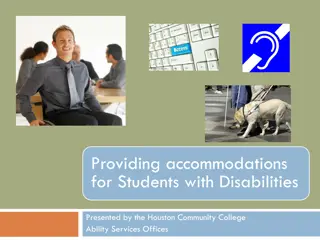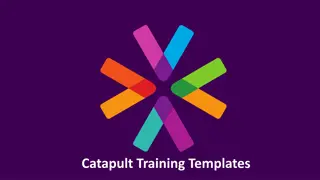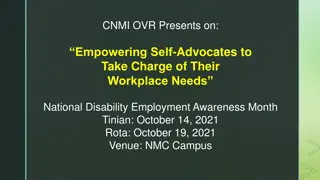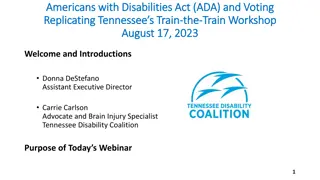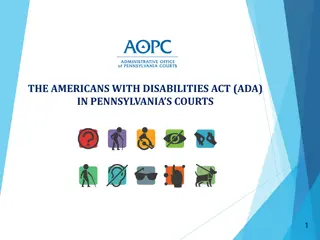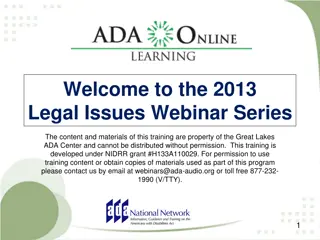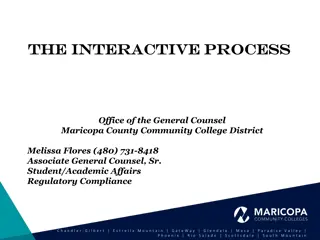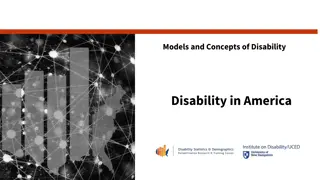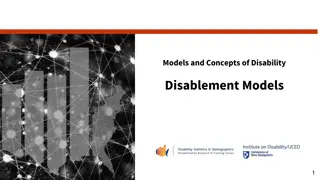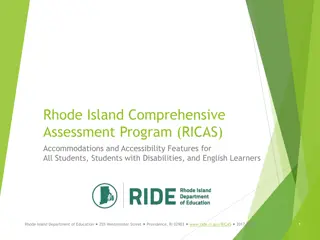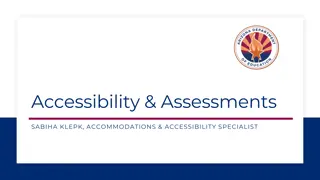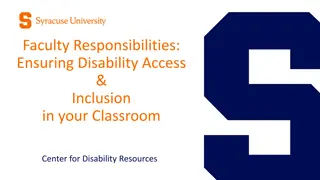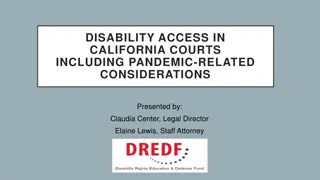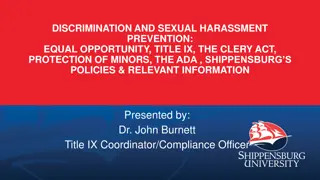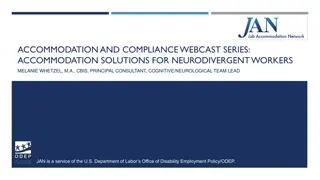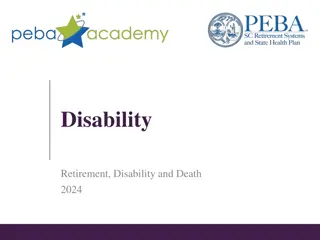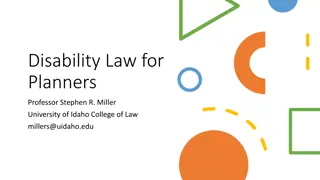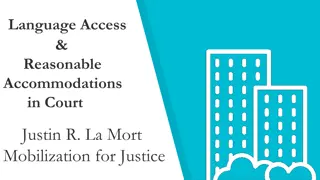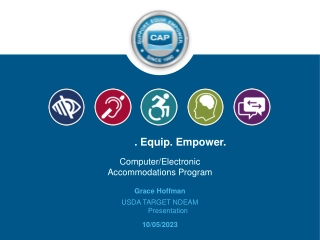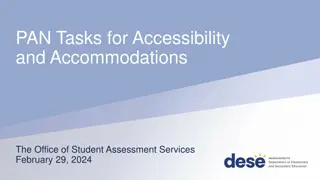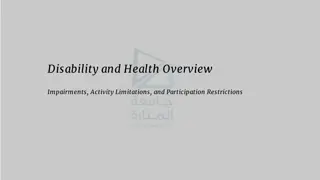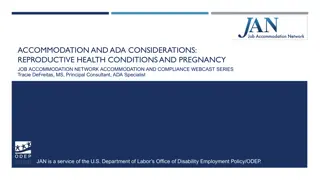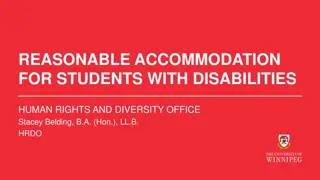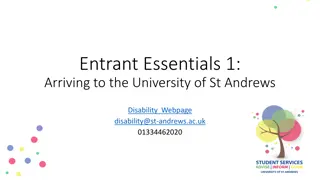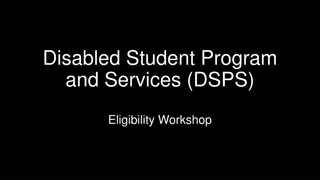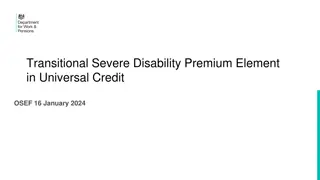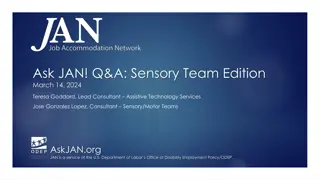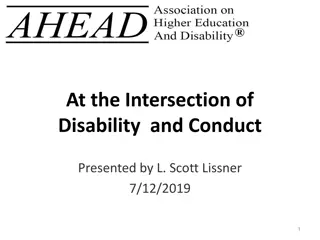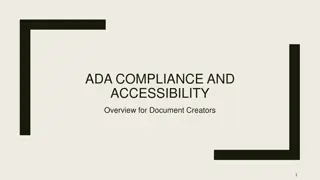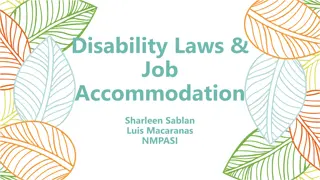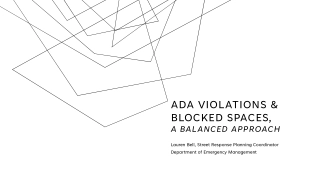Understanding ADA and Disability Accommodations in the Workplace
The Americans with Disabilities Act (ADA) ensures equal opportunities for individuals with disabilities and prohibits discrimination. This session covers the purpose of ADA, defining disability, reasonable accommodations, non-discrimination policies, and examples of ADA covered conditions. Eligible employees, including those who can perform essential job functions with or without accommodation, will benefit from learning about ADA compliance and creating an inclusive work environment.
- ADA compliance
- Disability accommodations
- Non-discrimination policy
- Workplace inclusivity
- Equal employment opportunities
Download Presentation

Please find below an Image/Link to download the presentation.
The content on the website is provided AS IS for your information and personal use only. It may not be sold, licensed, or shared on other websites without obtaining consent from the author. Download presentation by click this link. If you encounter any issues during the download, it is possible that the publisher has removed the file from their server.
E N D
Presentation Transcript
Office of Institutional Diversity and Equity Toya Camacho AVP for Institutional Diversity and Equity Title IX & ADA Coordinator 7/16/2024
Session Objectives At the end of the session, you will be able to: Identify the purpose of the ADA; Define disability ; Make reasonable accommodations; and Avoid discrimination based on disability. 7/16/2024
Non-Discrimination Policy Williams College, in compliance with state and federal law, does not discriminate in admission, employment, or administration of its programs and activities on the basis of race, color, sex, national origin, religion, age, disability, marital status, sexual orientation, gender identity or expression or military service. 7/16/2024
The Americans with Disabilities Act (ADA) The Americans with Disabilities Act is a federal law that prohibits discrimination against people with disabilities and requires equal access to public facilities, programs, activities, and services. One of the most important goals of this law is to give equal employment opportunities to qualified individuals with disabilities 7/16/2024
Examples of ADA Covered Conditions Depression Multiple sclerosis Hepatitis B Epilepsy Diabetes Cancer Hearing loss 7/16/2024
Defining Disability A physical or mental impairment that substantially limits one or more major life activities; (Caring for oneself, Walking, standing, sitting, reaching, lifting, and bending) Having a record of such impairment; or Being regarded as having such an impairment. 7/16/2024
Eligible employees include: A qualified personis someone who satisfies the requisite skill, experience, education, and other job-related requirements of the position and can perform the essential functions of the job, with or without a reasonable accommodation and without posing a direct threat to the health or safety of the individual or others. Part-time and full-time employees 7/16/2024
When to Start the Interactive Process Initiate the interactive process when the employee s disability is known or apparent. For example, when: Employee requests an accommodation Employee presents doctor s note with work restrictions Employer otherwise becomes aware of need for accommodation through third party or observation These requests and the resulting conversations between the employee and the supervisor starts the interactive process, an important component of the accommodation procedure. 7/16/2024
The Interactive Process These interactions can also help identify barriers the employee is experiencing. A barrier is some feature of the employee s job (or the job environment) that makes it difficult for the person with a disability to perform their job tasks. 7/16/2024
Essential Functions When evaluating whether a task is essential, it is important to consider the following: Content of the written job description, including any physical skills required to perform the job (i.e. must be able to move and transport objects weighing up to 40 frequently; must climb ladders to inspect work; etc.) 7/16/2024
Reasonable Accommodation The College will provide a reasonable accommodation to a qualified employee with a known disability unless the accommodation would impose an undue hardship. The employee must be qualified. That is, they must have the skills, education, and experience for the job. The employee must disclose they have a disability to the ADA Coordinator. 7/16/2024
The Request for an Accommodation Here are some examples of statements that can be a request for an accommodation: I m on a new medication and having trouble getting to work on time . I need time off for some treatment that my doctor is recommending . I m making more errors because I am having trouble seeing the data on the monitor . 7/16/2024
Requests for Accommodations? My feet hurt. I need a shorter route through the stockroom because the other way is too long and difficult with my leg problems. I just cannot stand for 8 hours anymore. 7/16/2024
The Request for an Accommodation There is no specific language required when an employee is making a request for an accommodation. That is, the employee does not have to use the word accommodation and they do not have to make the request in writing. 7/16/2024
Requesting Medical Information Request medical documentation and information Entitled to know the nature and duration of restrictions Not necessarily entitled to know diagnosis 7/16/2024
I need a closer parking space because the employee lot is too difficult with my leg problems is an accommodation request under the ADA. True or False? 7/16/2024
You should not transfer an employee to a different job to ease him back into work after returning from a medical leave if the employee has been released to work without restrictions. True or False? 7/16/2024
Examples of Accommodations Modifying the job application process Acquiring or modifying of equipment/devices Making facilities accessible Hearing aids or glasses 7/16/2024
Providing Equipment as an Accommodation Jessica is an computer specialist. Her job requires that she work the majority of the day, except for breaks and lunch, seated at her desk using the computer and phone to complete her job tasks. She has a chronic impairment and recently had back surgery. With her return to work, it was recommended she have a more supportive chair and an adjustable height desk as she was restricted from sitting for hours at a time. The equipment provided her the opportunity to work either sitting or standing while she completed her job tasks. 7/16/2024
What would you do? You are conducting job interviews for the position of administrative assistant. One of your applicants has a hand disability due to an accident. You are not sure if she can handle the computer work associated with the job. 7/16/2024
What would you do (cont.) Do you: Ask how he/she is able to type with her disability? Tell her he/she is not right for the job? Explain the duties of the job and ask if he/she can accomplish them? 7/16/2024
What would you do? A long-term employee starts having performance problems. When her supervisor talks to her about the problems, she responds that she is very stressed and is having difficulty handling her job duties. The supervisor doesn t know if this is an accommodation request and is afraid to ask for clarification for fear of violating the ADA s rules about making medical inquiries. 7/16/2024
ADA Takeaways ADA protects qualified individuals with disabilities from employment discrimination Accommodation requests can be verbal or written Keep HR or ADA Coordinator informed of any changes or updates on the employees restrictions. Consult with ADA Coordinator to start the interactive process 7/16/2024


